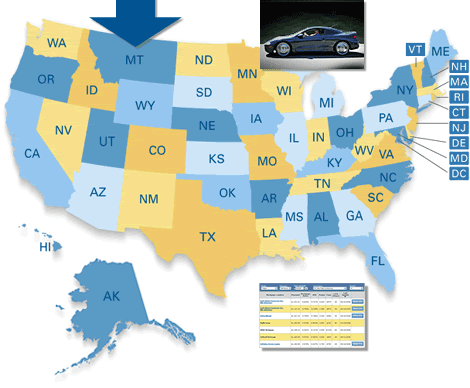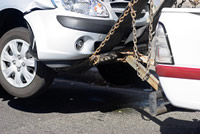Auto Insurance – Terms and Descriptions Explained
by Amy Lillard
Ever feel like your insurance agent is speaking another language? auto insurance is a relatively simple concept couched in confusing terms and details. Understanding your policy can be quite the feat.
By learning key terms that you'll find when shopping for insurance or deciphering your coverage, you can feel secure in your insurance.
The Basics
First, some key definitions:
• Term: A policy term is the length of time that your insurance policy is valid. Many policies have a term of 6-12 months.
• Deductible: This is the maximum amount you will pay for repairs and other costs in the case of an accident. You choose the amount of the deductible, and it should the highest amount you can comfortably pay out of pocket.
• Premium: Your monthly payments. A higher deductible means lower premiums. State regulations, driving statistics in your area, and other factors can also contribute to the amount of your premium.
• Liability: Basically, this denotes your legal responsibility. If you cause an accident, you may be found liable for the damages to your own car and the other car(s).
• Limits: This is the maximum amount an insurance company will pay for a covered loss. In most states, laws pinpoint the minimum insurance limits that drivers must have.
• VIN: Vehicle Identification Number. This is a 17-digit number unique to every car, containing the serial number and abbreviations for make, model and year. The VIN is important when you buy your auto insurance policy, and when any claims are made.
• Claim: After an accident, a policyholder may file a claim. This simply means they request to be reimbursed for a loss that's covered by car insurance.
Digging Deeper
When you take a close look at your policy, and when you file a claim, other terms will become important:
-
• Exclusions: Listed within your policy are the specific situations and items that are not covered by your insurance, called exclusions.
• Depreciation: The decline in a your car's value due to age, wear and tear, or obsolescence. This can result in lower benefits in case of an accident.
• Benefit: The amount paid by your auto insurance company in the case of a claim.
• Adjuster: An official for the auto insurance company (or an independent professional) who investigates and settles auto insurance claims.
• Actual Cash Value: This figure is calculated by determining your car's original value, minus the amount of depreciation since you bought it. Insurance companies will only pay the actual cash value of the car.
• Endorsements: Changes to the original insurance contract, including a modified deductible or additional cars under the policy.
New and Used Auto Loan Rates
Choose Your State Below

Start by selecting your state
Coverage
The language of different auto insurance coverage is even more complex. The typical coverage plans include liability (bodily injury and property damage), collision, personal injury protection, medical benefits, and uninsured/underinsured coverage. These plans are described in detail in our article on auto insurance types.
Other additions can include:
-
• Accidental death coverage: Sometimes a part of personal injury protection coverage, this provides a payment in case of a policyholder's death.
• Emergency Roadside Service: Sometimes called towing coverage, this pays a fixed amount for towing, tire changing, gas, oil and water delivery, battery services, and lockout services.
• Income Loss coverage: Sometimes a part of personal injury protection, this plan helps you recover portions of your lost salary and other expenses you may incur as you try to return to work after an accident.
• No-Fault Insurance: Liability does not need to be assigned to settle a claim under this plan. In some states, called no-fault states, insurance companies are legally required to pay a policyholder's covered losses, no matter who is responsible for an accident.
To learn more about auto insurance, read our continuing series, including articles on ideal amount of coverage, how to file claims, tips for after an accident, and more.
Other related articles:
Auto Insurance - Finding the Best Plan for You
Auto Loans Advice: New Cars & Used Cars
Car Buying vs Car Leasing
Health Insurance Basics
Guideline for Purchasing Life Insurance

Life Insurance
- Term, Whole, Universal, Varialble Life Insurance
- Guidelines for Purchasing Life Insurance
- Life Insurance: Finding the Best Rates
- Life Insurance Explained: Types and Coverage

Medical Insurance
- Health Insurance Basics
- Healthcare Costs and Retirement
- Critical Flaws in HealthCare
- Disability Insurance
- Tips on Buying Long Term Care Insurance
General Insurance Articles

Homeowners Insurance
- Homeowners Insurance Premiums Policy
- Homeowners Insurance: Filing a Claim
- Punxsutawney Phil's forecast-homeowners insurance rates
- Homeowners Insurance Costly Trends
- Home Insurance Costs on the Rise, Coverage Options Decrease
- Homeowners Insurance: The Special Policy for Condo Owners
- Homeowners Insurance College Students Coverage
- Underinsured Homeowners
- Beyond Homeowners Insurance: Coverage for Renters
- What Home Owners Insurance Do You Need? Tips for the Best
- Home Insurance Quotes: Types of Home Owners Insurance
- Home Insurance: How are Insurance Quotes Determined?
- Homeowners Insurance: Finding the Best Quotes


Auto Insurance

- Hitting the brakes on auto insurance costs
- Car Insurance Quotes: Discovering best deals
- Car Ins Quotes: What Factors Determine Rates
- Auto Insurance Quotes and Policies: Commonly Used Terms
- Shopping Prep: What You'll Need to Obtain Car Insurance Quotes
- Auto Insurance Terms & Descriptions
- Understanding Your Auto Insurance Quotes: The 7 Types of Car Insurance
- Auto Insurance - Best Plan for You
- How much Car Insurance to buy
- Need to Know Auto Ins Policy
- Automobile Insurance Settlement Advice
- Managing Auto Insurance: What to Do After an Accident
- Filing a Car Insurance Claim: Steps to Follow after an Accident
- Auto Insurance Steps to Filing a Claim
- Tips - Reducing your Auto Insurance Expenses
- Driving a Hard Bargain
- Slow Down Drive Safely
- Cheapest & Most Expensive Vehicles to Insure
